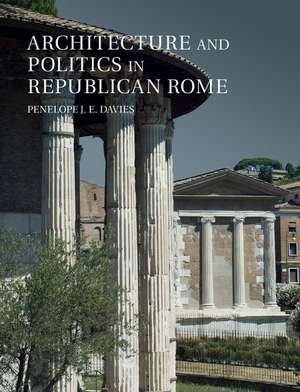Architecture and Politics in Republican Rome
Autor Penelope J. E. Daviesen Limba Engleză Paperback – 8 iun 2020
Preț: 329.76 lei
Nou
Puncte Express: 495
Preț estimativ în valută:
63.10€ • 65.20$ • 52.49£
63.10€ • 65.20$ • 52.49£
Carte disponibilă
Livrare economică 26 februarie-12 martie
Preluare comenzi: 021 569.72.76
Specificații
ISBN-13: 9781107476110
ISBN-10: 1107476119
Pagini: 376
Ilustrații: 45 b/w illus. 200 colour illus. 18 maps
Dimensiuni: 217 x 278 x 18 mm
Greutate: 1 kg
Editura: Cambridge University Press
Colecția Cambridge University Press
Locul publicării:New York, United States
ISBN-10: 1107476119
Pagini: 376
Ilustrații: 45 b/w illus. 200 colour illus. 18 maps
Dimensiuni: 217 x 278 x 18 mm
Greutate: 1 kg
Editura: Cambridge University Press
Colecția Cambridge University Press
Locul publicării:New York, United States
Cuprins
Introduction; 1. A republic takes shape; 2. An age of individualism, c.338–218 BCE; 3. A state of fear and new horizons, c.217–133 BCE; 4. Turmoil and tension, c.133–90 BCE; 5. Civil war and aftermath, c.89–70 BCE; 6. Pompey, Caesar, and rivals: c.69–55 BCE; 7. Caesar, Pompey, and rivals: c.54–44 BCE; Endnotes; Bibliography; Index.
Recenzii
'In this perceptive book Davies interrogates the evolving, mutually exploitative exchange between architecture and politics in Rome of the Republic. Drawing on deep research, she expertly reveals how such factors as term limits, religious traditions, materials, and cultural shifts constrained and enriched politicians and architectural projects alike. It is an informative and compelling story, told with verve and insight.' Diane Favro, University of California, Los Angeles
'Davies' achievement is to stand above the topographical fray and to keep the focus at all points on the bigger picture of historical context. The consequence is a volume that is truly innovative. We have seen many volumes on Roman Republican history with only glancing reference to architecture, and some (but not many) on Republican Art and Architecture, with only generic reference to historical context. What Architecture and Politics in Republican Rome achieves is to pull together these story lines into an integrated narrative that is so persuasive we may ask ourselves why it has never been done before.' Andrew Wallace-Hadrill, University of Cambridge
'Davies provides what amounts to a definitive architectural history of republican Rome (509–44 BCE). Distinguishing this volume from previous treatments is not only Davies's comprehensive approach and skilled integration of historical sources alongside presentation of the monuments, but also her inclusion of state-of-the-art illustrations, among them phase plans, digital reconstructions, and photographs, most reproduced in color. What emerges is a gradually evolving urban fabric for the city, one realized not by overarching designs, but rather by piecemeal agency and accretion, prior to the grand integrative schemes imposed during the imperial period. The temples, public spaces, fortifications, theaters, and other monuments that progressively defined the cityscape of Rome during the four centuries of the Republic not only overlay the fortunes of the metropolis itself but reflect the power struggles of class and men of action, culminating in the civil wars and accompanying Rome's transformation to the Empire.' Choice
'Davies' achievement is to stand above the topographical fray and to keep the focus at all points on the bigger picture of historical context. The consequence is a volume that is truly innovative. We have seen many volumes on Roman Republican history with only glancing reference to architecture, and some (but not many) on Republican Art and Architecture, with only generic reference to historical context. What Architecture and Politics in Republican Rome achieves is to pull together these story lines into an integrated narrative that is so persuasive we may ask ourselves why it has never been done before.' Andrew Wallace-Hadrill, University of Cambridge
'Davies provides what amounts to a definitive architectural history of republican Rome (509–44 BCE). Distinguishing this volume from previous treatments is not only Davies's comprehensive approach and skilled integration of historical sources alongside presentation of the monuments, but also her inclusion of state-of-the-art illustrations, among them phase plans, digital reconstructions, and photographs, most reproduced in color. What emerges is a gradually evolving urban fabric for the city, one realized not by overarching designs, but rather by piecemeal agency and accretion, prior to the grand integrative schemes imposed during the imperial period. The temples, public spaces, fortifications, theaters, and other monuments that progressively defined the cityscape of Rome during the four centuries of the Republic not only overlay the fortunes of the metropolis itself but reflect the power struggles of class and men of action, culminating in the civil wars and accompanying Rome's transformation to the Empire.' Choice
Notă biografică
Descriere
This book argues that Republican Rome and its component buildings were inextricably intertwined with government, which they perpetuated and challenged.
